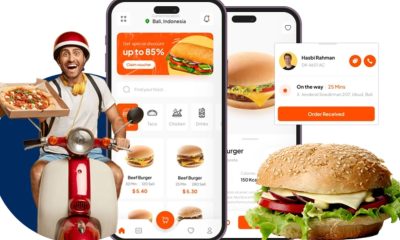Business
The Evolution of Food Delivery: From Dialing for Pizza

Food delivery has come a long way from the days when calling a local pizzeria was the primary way to have a meal delivered to your doorstep. In this era of technology and convenience, we’ve witnessed a remarkable evolution in the world of food delivery. From the telephone-based orders of the past to the rise of app-based services today, this evolution has reshaped the way we dine at home or the office.
The Pre-App Era: Dialing for Pizza
Phone Orders and Menus: Back in the day, if you wanted to order food for delivery, you had to pick up the phone, find a paper menu, and call your chosen restaurant. This method was often time-consuming, and customers had to deal with busy lines, occasional misunderstandings, and the limitations of paper menus.
Limited Choices: In the pre-app era, the range of options was often restricted to local pizza or fast-food joints. While pizza was a go-to delivery choice, more diverse cuisines were harder to come by, especially in less urban areas.
Cash Transactions: Payment was typically handled in cash upon delivery, which could be inconvenient and sometimes led to incorrect change or payment issues.
The Advent of Online Ordering
The Internet Revolution: As the internet became more accessible, restaurants began establishing websites to provide an online presence. This marked the beginning of online ordering, which allowed customers to view menus and place orders more conveniently through their computer.
Third-Party Platforms: Several third-party platforms emerged, such as Grubhub and Seamless, acting as intermediaries between restaurants and customers. These platforms facilitated online ordering and expanded the variety of restaurants available for delivery.
Digital Payment Options: With online ordering, digital payment options like credit cards became more prevalent, making transactions smoother and more secure.
The App-Based Food Delivery Revolution
Smartphones and Apps: The true game-changer came with the widespread use of smartphones. Food delivery services developed dedicated apps that allowed users to browse
menus, place orders, and track deliveries effortlessly. Mobile apps offered a seamless and user-friendly experience.
Expanded Choices: App-based services brought an explosion of culinary options. Customers could now enjoy a diverse range of cuisines from local restaurants and national chains, all at their fingertips.
Transparent Tracking: With GPS integration, customers could track their orders in real-time. This feature not only enhanced the user experience but also improved the efficiency of deliveries.
Rating and Review Systems: App-based food delivery services introduced rating and review systems, allowing customers to share their dining experiences and helping others make informed choices.
Promotions and Loyalty Programs: Many apps offer promotions, discounts, and loyalty programs, making dining at home even more appealing.
The Impact on Restaurants
Expanding Customer Base: Restaurants that embraced app-based delivery platforms found access to a broader customer base, including those who might not have discovered them otherwise.
Challenges of Delivery: With the surge in delivery orders, restaurants had to adapt their operations to handle increased demand and maintain food quality during transit.
Economic Impact: For some restaurants, partnering with app-based services became a significant source of revenue, especially during challenging times such as the COVID-19 pandemic.
The Rise of Ghost Kitchens: App-based services contributed to the rise of ghost kitchens, facilities dedicated solely to fulfilling delivery and takeout orders. This innovative concept allowed restaurants to reduce overhead costs while still reaching customers.
The Customer Perspective
Convenience and Choice: App-based food delivery services have revolutionized dining by offering unparalleled convenience and an extensive array of dining options. It’s no longer just about ordering pizza; it’s about having gourmet cuisine delivered to your doorstep.
Customization: Customers can customize their orders, selecting dietary preferences, portion sizes, and specific instructions, making dining at home a personalized experience.
Savings and Promotions: Many apps offer exclusive deals and discounts, making dining at home not only convenient but also budget-friendly.
User Experience: The intuitive interfaces, real-time tracking, and review systems have significantly improved the user experience, ensuring that customers get exactly what they want.
Challenges and Concerns
Delivery Fees: While the convenience is undeniable, delivery fees and service charges can add up. Customers are sometimes faced with the decision of whether to dine out, pick up their order, or pay for delivery.
Quality Control: Ensuring that the food arrives hot and fresh can be a challenge, and some customers may have concerns about the quality of their delivered meals.
Environmental Impact: The increase in food delivery comes with environmental considerations, including packaging waste and carbon emissions from delivery vehicles.
Competition and Consolidation: The food delivery market has become highly competitive, with several major players vying for dominance. This has led to concerns about market consolidation and its impact on restaurants and consumers.
Conclusion:
The evolution of Food Delivery In Kolkata, from the days of calling for pizza to the current era of app-based services, has revolutionized the way we dine. The convenience and variety offered by these services have made dining at home a delightful experience, and it’s clear that they are here to stay.
As we move forward, it’s essential to address the challenges associated with food delivery, from fees and quality control to environmental considerations. Moreover, as competition continues to intensify, ensuring fair practices and support for restaurants and delivery personnel will be crucial.
Ultimately, the evolution of food delivery has reshaped our dining habits, offering a world of culinary delights at our doorstep. It’s a testament to the adaptability of the food industry and the ever-changing preferences of consumers in the digital age.




